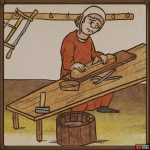Text
The society of the medieval town was primarily composed of craftsmen and merchants who ensured its economic growth. Based on municipal rights, they had the right to practice their trade and market rights.
Apart from privileges such as the protection and support of the town in operation, healthcare, and sufficient food supply, it was their duty to pay taxes on every sale or export of goods outside the town’s borders. Essentially, the status of the community depended on them, so it was important that they did not relocate, did not practice their profession elsewhere, and passed on the craft to future generations.
During one century, several craftsmen of the same profession worked in the town. These craftsmen gradually began to form groups with politico-economic rules, known as guilds.
They had their own seals, stamps, and banners bearing the guild’s coat of arms designated by the ruler. Those who belonged to the guild had support from others, and they collectively agreed on prices, sales regulations, training rules, and obligations. Only guild members could sell goods.


No Comments